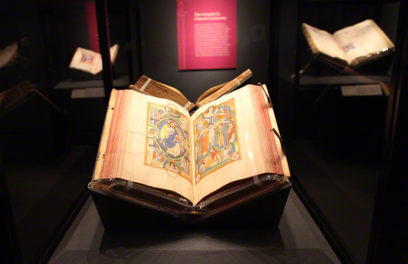It’s almost Thanksgiving, and to get ready for the holiday, we’ve been thinking of what to put on the table. There will be turkey, and cranberries, and mashed potatoes, and pumpkin pie. But not everyone likes the classic dessert—so we looked into the distant past and to a different continent to find something new.
This cream custard tart is essentially pumpkin pie without the pumpkin and is sweet enough to please the picky relative with medieval taste.
From The Medieval Cookbook by Maggie Black
Ingredients
Pulverized dried saffron strands
Shortcrust pastry made with 225g/8oz flour, 65 g/2 ½ oz butter, 40g/ 1 ½ oz lard, and cold water to mix
6 egg yolks
350 ml/12 fl oz/ 1 ½ cups double cream
65 ml/ 44 fl oz/ ½ cup milk
65 g/ 2 ½ oz white sugar
¼ teaspoon sea salt
Instructions
Soak the saffron in 2 tablespoons water until the water is deep gold in color. Use the pastry to make a case 5 cm/ 2 inches deep in a 20-cm/8-inch pie plate or cake tin with a loose bottom.
Bake ‘blind in a pre-heated oven at 200°C/400°F/Gas Mark 6 for 15-20 minutes, then remove the filling of dried beans and return the case to the oven at about 160°C/325°F/Gas Mark 3 for 6–8 minutes until dried out and firm. Remember a cake tin is deeper than a pie plate, so the case in it may need loner baking than usual.
Beat the egg yolks lightly in a bowl, then beat in the cream, milk, sugar, saffron, water, and salt, pour the custard into the pastry case. Bake at 160°C/325°F/Gas mark 3 for about 45 minutes or until it is just set in the center. Serve warm.
Make small tarts if you prefer. The full recipe quantity of pastry will make 36 tarts, using a 7.5 cm/3 in cutter. You will need two-thirds of the filling for them.
And when you are asked where you got this idea, you can share the original recipe:
Doucetes. Take Cream a gode cupfulle, & put it on a straynour, thanne take yolkes of Eyroun, and put ther-to, & a lytel mylke; then strayne it throw a straynour in-to a bolle; ten take a Sugre y-now, put ther-to, or ellys hony forde faute of Sugre, than coloure it wiht Safroun; than take thin cofyns, & put it in the ovynne letre, & tat hem ben hardyd; than take a dyssche y-fastenyd on teh pelys ende, & pore thin comade in-to the dyssche, & fro the dyssche in-to the cofyns; & whan tehy don a-ryse wet, teke hem out , ee serue hem forth.
(Two Fifteenth-Century Cookery Books, British Museum, Harleian Ms. 279, p. 50).
The Medieval Cookbook is available in North America from Getty Publications and outside North America from the British Museum.





Comments on this post are now closed.